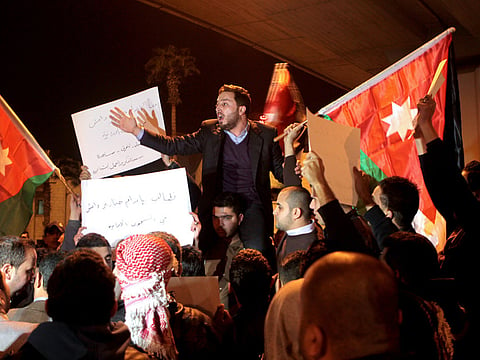Family and nation mourn pilot killed by Daesh
Relatives tried to hide the news from Muath’s family, but it was too late

Amman: When relatives learned on Tuesday night that Daesh had released a video showing the death of a Jordanian fighter pilot, 1st Lt Muath Al Kasaesbeh, they tried to keep it from his mother, Essaf, and his wife, Anwar. They switched off the television and tried to wrest a smartphone from his wife’s hand, but she had already seen a mobile news bulletin.
Married only six months, Anwar ran crying into the street, calling her husband’s name and saying, “Please God, let it not be true.” Essaf fell to the floor screaming, pulled her headscarf off and started tearing at her hair.
That was before they knew how he had been killed. No one dared let them know right away that Al Kaseasbeh’s tormentors had apparently burned him alive inside a cage, a killing that was soon described as the most brutal in the group’s bloody history.
Jordan responded rapidly, executing Sajida Al Rishawi, a convicted suicide bomber, and Ziad Al Karbouli, a top lieutenant of Al Qaida in Iraq, before dawn on Wednesday, according to the official news agency Petra.
Both prisoners had already been sentenced to death for terrorism offences. Al Karbouli was accused as one of the planners of the 2005 hotel bombings in Amman that killed more than 57 people; Al Rishawi was the only one of four suicide bombers in that attack whose explosive vest failed to detonate.
Happier days
On Tuesday, Anwar Al Kaseasbeh had been laughing at the memory of her husband’s delight when he discovered that her family kept rabbits in their home. After they married, her parents gave them the rabbits.
“It was so funny, he was so happy about those rabbits,” Anwar told a visiting reporter about her 26-year-old husband. “He told me how he always wanted rabbits.”
The video, with its references to Daesh’s punishment of nations like Jordan that joined the US-led coalition against it, appeared to be an attempt to cow the Arab states and others that have agreed to battle the militants in Syria.
It appeared to have had the opposite effect in Jordan, which suggested its resolve had been stiffened. But the capture of the pilot had already hurt the coalition, with one country suspending its air strikes and demanding the group improve its search and rescue efforts for captured members.
The release of the video came after weeks of growing anxiety in Jordan, as the country’s leaders had spent the past weeks trying desperately to win the release of Al Kaseasbeh, a member of an important tribe and the first fighter for the coalition bombing the Daesh to be captured.
Their attempts became more complicated late last month when Daesh suddenly entangled the pilot’s fate with that of a Japanese man it held hostage, demanding that Jordan release a would-be suicide bomber on death row in exchange for him.
The extremists gave Jordan a deadline of last Thursday to set the prisoner free, saying Al Kaseasbeh would be killed otherwise. Jordanian officials expressed willingness to bargain — a major concession to the militants — but refused to release the would-be bomber until they received proof that the pilot was alive.
On Tuesday, Jordanian officials said they learned the pilot had actually been killed on January 3, suggesting that their caution was justifiable. They did not, however, explain where they got the information.
Gruesome
Even by Daesh standards, the latest propaganda video was particularly gruesome. The footage alternates between images of the pilot while he was alive with segments showing the rubble of buildings and the burned bodies of Syrians allegedly killed in coalition air strikes. Daesh members took to Twitter to applaud the pilot’s death, calling it an eye for an eye.
At the end of the 22-minute video, a Daesh fighter sets a powder fuse alight as Al Kaseasbeh watches, his clothes drenched in fuel. The flames race into the cage and engulf him. The camera lingers, showing close-ups of his agony, before concluding with pictures of what Daesh claimed were other Jordanian pilots and an offer of 100 gold coins for whoever kills one of them.
Jordan’s military on Tuesday vowed to avenge the pilot’s death, and Jordan’s King Abdullah II planned to cut short a trip to Washington, returning by Wednesday, according to Jordanian media.
“The blood of our hero martyr Muath Al Kaseasbeh will not go for nothing,” said Mamdouh Al Ameri, a spokesman for the Jordanian military. “And the revenge will be equal to what happened to Jordan.” The spokesman did not specify the meaning of that threat.
Jordan is among several Arab countries taking part in US-led air raids against Daesh positions in Syria. Two other Arab states, plus Iraq, are members of the coalition in other capacities.
Al Kaseasbeh was allegedly shot down in his F-16 fighter bomber on December 24 during an air operation against Daesh positions not far from the militants’ stronghold of Raqqa in northern Syria.
Sign up for the Daily Briefing
Get the latest news and updates straight to your inbox



